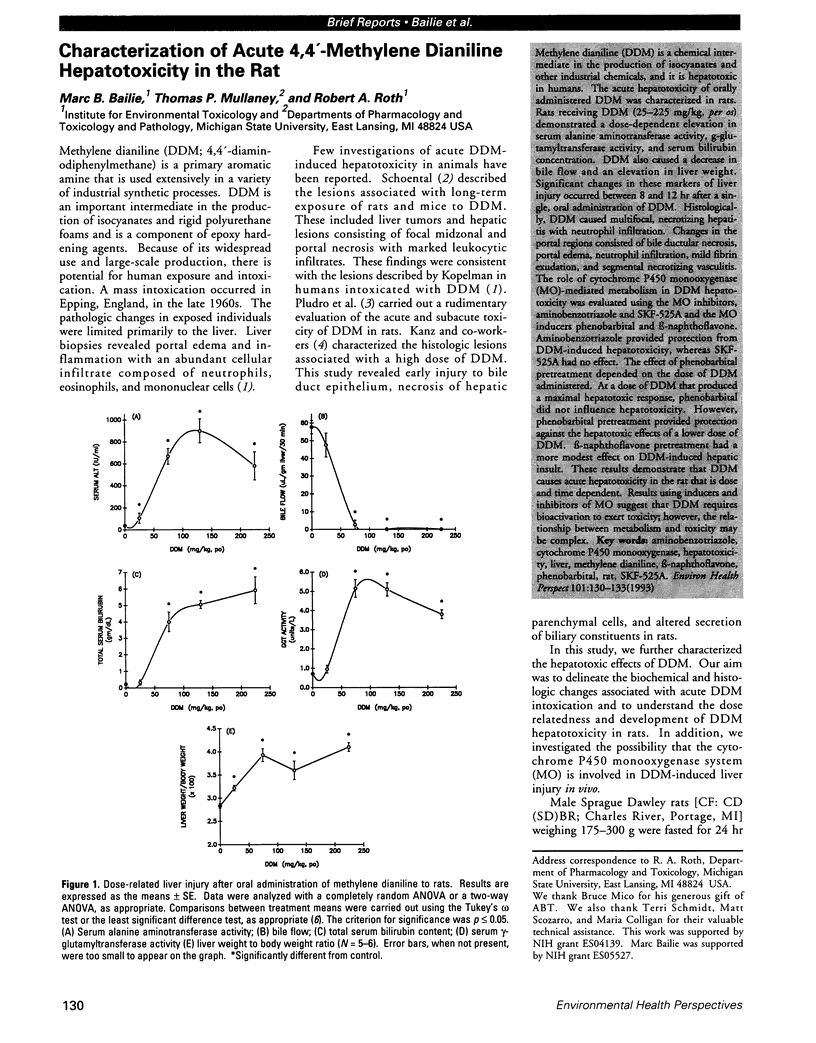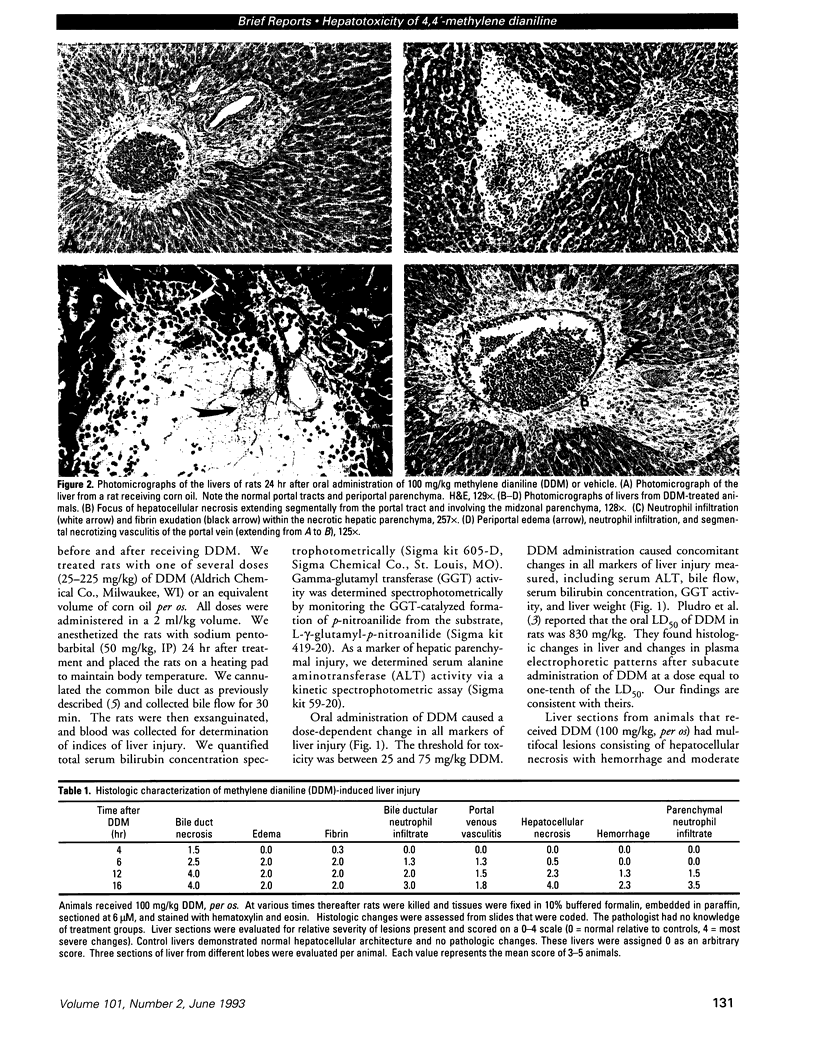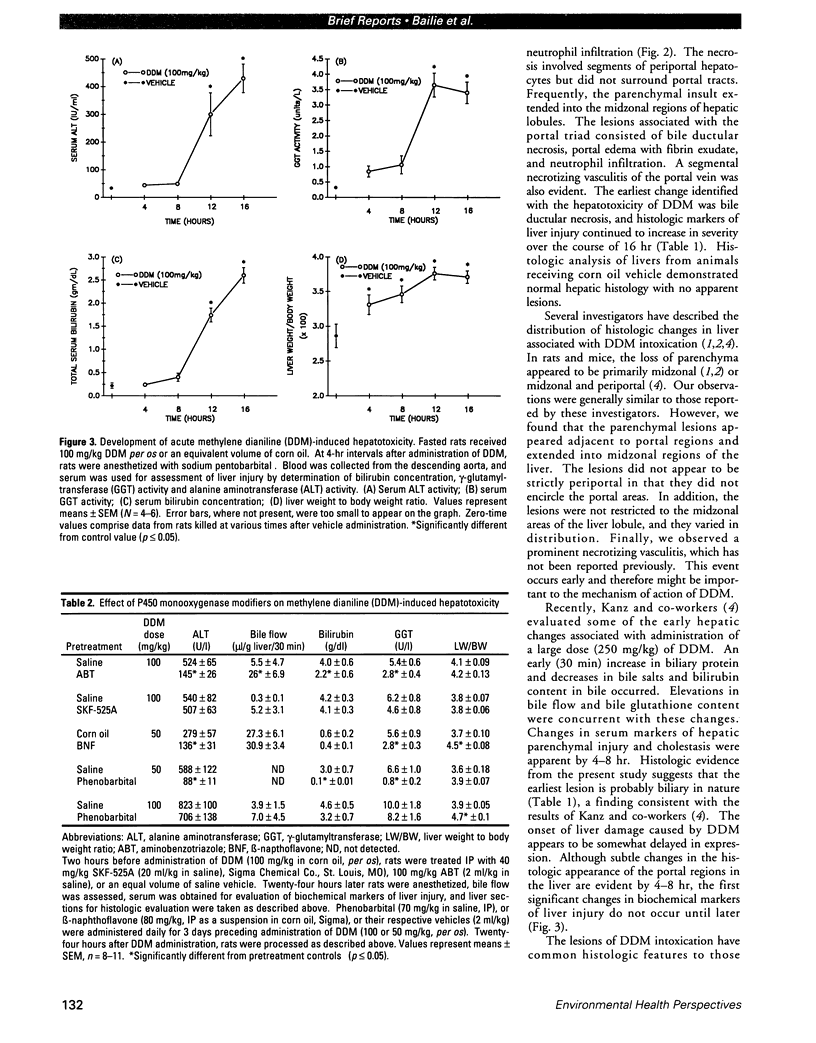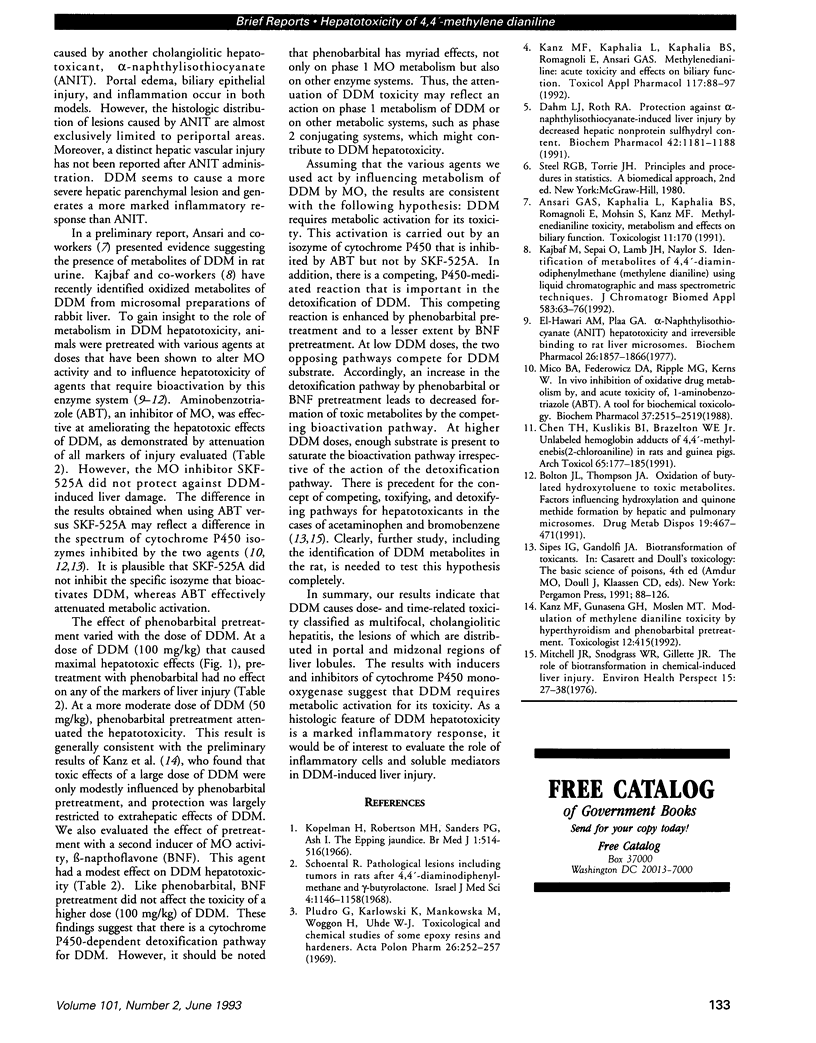Abstract
Methylene dianiline (DDM) is a chemical intermediate in the production of isocyanates and other industrial chemicals, and it is hepatotoxic in humans. The acute hepatotoxicity of orally administered DDM was characterized in rats. Rats receiving DDM (25-225 mg/kg, per os) demonstrated a dose-dependent elevation in serum alanine aminotransferase activity, g-glutamyltransferase activity, and serum bilirubin concentration. DDM also caused a decrease in bile flow and an elevation in liver weight. Significant changes in these markers of liver injury occurred between 8 and 12 hr after a single, oral administration of DDM. Histologically, DDM caused multifocal, necrotizing hepatitis with neutrophil infiltration. Changes in the portal regions consisted of bile ductular necrosis, portal edema, neutrophil infiltration, mild fibrin exudation, and segmental necrotizing vasculitis. The role of cytochrome P450 monooxygenase (MO)-mediated metabolism in DDM hepatotoxicity was evaluated using the MO inhibitors, aminobenzotriazole and SKF-525A and the MO inducers phenobarbital and beta-naphthoflavone. Aminobenzotriazole provided protection from DDM-induced hepatotoxicity, whereas SKF-525A had no effect. The effect of phenobarbital pretreatment depended on the dose of DDM administered. At a dose of DDM that produced a maximal hepatotoxic response, phenobarbital did not influence hepatotoxicity. However, phenobarbital pretreatment provided protection against the hepatotoxic effects of a lower dose of DDM. beta-naphthoflavone pretreatment had a more modest effect on DDM-induced hepatic insult. These results demonstrate that DDM causes acute hepatotoxicity in the rat that is dose and time dependent. Results using inducers and inhibitors of MO suggest that DDM requires bioactivation to exert toxicity; however, the relationship between metabolism and toxicity may be complex.
Full text
PDF



Images in this article
Selected References
These references are in PubMed. This may not be the complete list of references from this article.
- Bolton J. L., Thompson J. A. Oxidation of butylated hydroxytoluene to toxic metabolites. Factors influencing hydroxylation and quinone methide formation by hepatic and pulmonary microsomes. Drug Metab Dispos. 1991 Mar-Apr;19(2):467–472. [PubMed] [Google Scholar]
- Chen T. H., Kuslikis B. I., Braselton W. E., Jr Unlabeled hemoglobin adducts of 4,4'-methylenebis (2-chloroaniline) in rats and guinea pigs. Arch Toxicol. 1991;65(3):177–185. doi: 10.1007/BF02307306. [DOI] [PubMed] [Google Scholar]
- Dahm L. J., Roth R. A. Protection against alpha-naphthylisothiocyanate-induced liver injury by decreased hepatic non-protein sulfhydryl content. Biochem Pharmacol. 1991 Aug 22;42(6):1181–1188. doi: 10.1016/0006-2952(91)90252-z. [DOI] [PubMed] [Google Scholar]
- El-Hawari A. M., Plaa G. L. alpha-Naphthylisothiocyanate (ANIT) hepatotoxicity and irreversible binding to rat liver microsomes. Biochem Pharmacol. 1977 Oct 15;26(20):1857–1866. doi: 10.1016/0006-2952(77)90159-9. [DOI] [PubMed] [Google Scholar]
- Kajbaf M., Sepai O., Lamb J. H., Naylor S. Identification of metabolites of 4,4'-diaminodiphenylmethane (methylene dianiline) using liquid chromatographic and mass spectrometric techniques. J Chromatogr. 1992 Nov 27;583(1):63–76. doi: 10.1016/0378-4347(92)80345-q. [DOI] [PubMed] [Google Scholar]
- Kanz M. F., Kaphalia L., Kaphalia B. S., Romagnoli E., Ansari G. A. Methylene dianiline: acute toxicity and effects on biliary function. Toxicol Appl Pharmacol. 1992 Nov;117(1):88–97. doi: 10.1016/0041-008x(92)90221-d. [DOI] [PubMed] [Google Scholar]
- Kopelman H., Robertson M. H., Sanders P. G., Ash I. The Epping jaundice. Br Med J. 1966 Feb 26;1(5486):514–516. doi: 10.1136/bmj.1.5486.514. [DOI] [PMC free article] [PubMed] [Google Scholar]
- Mico B. A., Federowicz D. A., Ripple M. G., Kerns W. In vivo inhibition of oxidative drug metabolism by, and acute toxicity of, 1-aminobenzotriazole (ABT). A tool for biochemical toxicology. Biochem Pharmacol. 1988 Jul 1;37(13):2515–2519. doi: 10.1016/0006-2952(88)90240-7. [DOI] [PubMed] [Google Scholar]
- Mitchell J. R., Snodgrass W. R., Gillette J. R. The role of biotransformation in chemical-induced liver injury. Environ Health Perspect. 1976 Jun;15:27–38. doi: 10.1289/ehp.761527. [DOI] [PMC free article] [PubMed] [Google Scholar]
- Schoental R. Pathological lesions, including tumors, in rats after 4,4'-diaminodiphenylmethane and gamma-butyrolactone. Isr J Med Sci. 1968 Nov-Dec;4(6):1146–1158. [PubMed] [Google Scholar]






